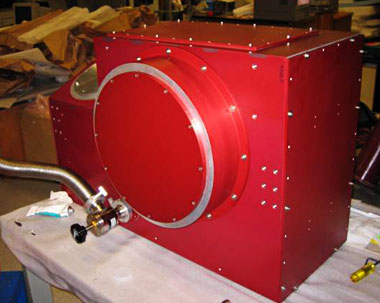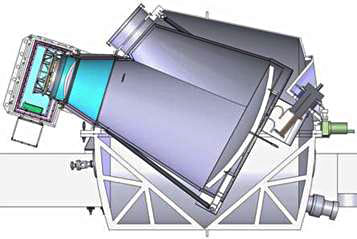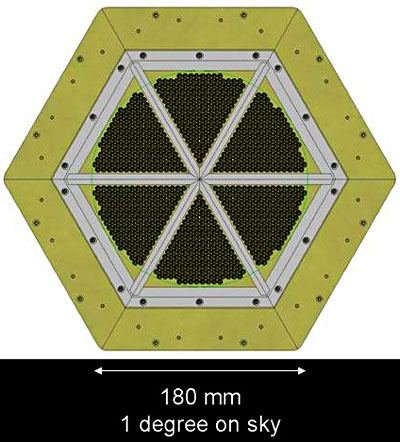|
|
 RECEIVER RECEIVER
 | CRYOGENICS |
|
 |
|
| |
The superconducting detectors used for the South Pole Telescope must be held at an extremely low temperature in order to operate. This temperature is achieved through 5 stages of cooling. A two-stage mechanical cooler called a Pulse-Tube Cooler cools the inner parts of the receiver cryostat to a few degrees above absolute zero. A 3-stage pumped-helium refrigerator is then used to achieve a final temperature of approximately one quarter of a degree above absolute zero.
|
| |
 This red vessel is the "receiver cryostat", shown during testing at the University of California, Berkeley, which holds the detectors at low temperatures. When at the South pole, the circular plate shown in the picture is removed and the receiver cryostat is bolted onto the optics cryostat.
This red vessel is the "receiver cryostat", shown during testing at the University of California, Berkeley, which holds the detectors at low temperatures. When at the South pole, the circular plate shown in the picture is removed and the receiver cryostat is bolted onto the optics cryostat.
|
| |
 The receiver cryostat is shown in the left of this picture, bolted onto the optics cryostat, which contains the 1-meter secondary mirror.
The receiver cryostat is shown in the left of this picture, bolted onto the optics cryostat, which contains the 1-meter secondary mirror.
|
| |
 | DETECTOR ARRAY |
|
 |
|
| |
 The receiver cryostat is designed to operate close to 1000 detectors, arranged in a roughly circular geometry.
The receiver cryostat is designed to operate close to 1000 detectors, arranged in a roughly circular geometry.
The full size of the array is about the size of your outstretched hand. Each "wedge", or triangle, of the full array can be operated to be sensitive to a different wavelength of incoming CMB light, using special filters. Since the detectors are bolometric --- i.e., they absorb radiation at any and all wavelengths --- many levels of filtering are required to ensure that only the roughly 2-millimeter waves from the Cosmic Microwave Background are absorbed, and not the much larger amounts of radiation in the infrared that can get into the cryostat. Furthermore, filtering can be done differently for each wedge of detectors so that we can separately observe the sky in different wavelengths.
|
| |
 | READOUT |
|
 |
|
| |
Measuring the output of the 1000 detectors requires either thousands of wires or a scheme to read out many detectors with a single amplifier system. We use electrical-current-detecting-and-amplifying systems built with Superconducting Quantum Interference Devices (SQUIDs), each of which reads out 8 or more detectors with a single amplifier channel.
|
| |
|
|
 RECEIVER
RECEIVER